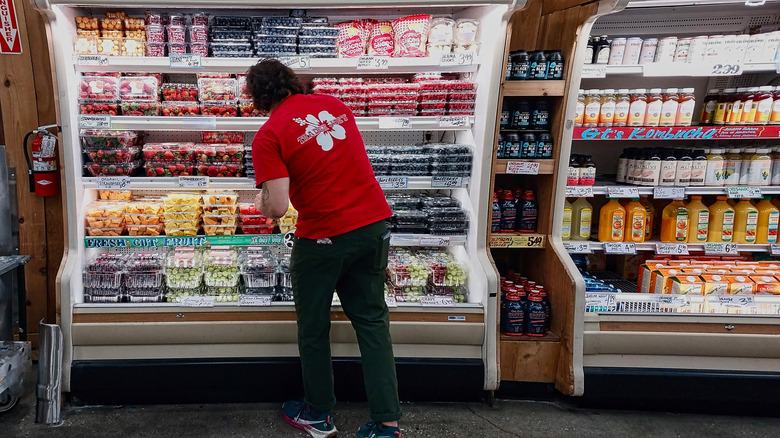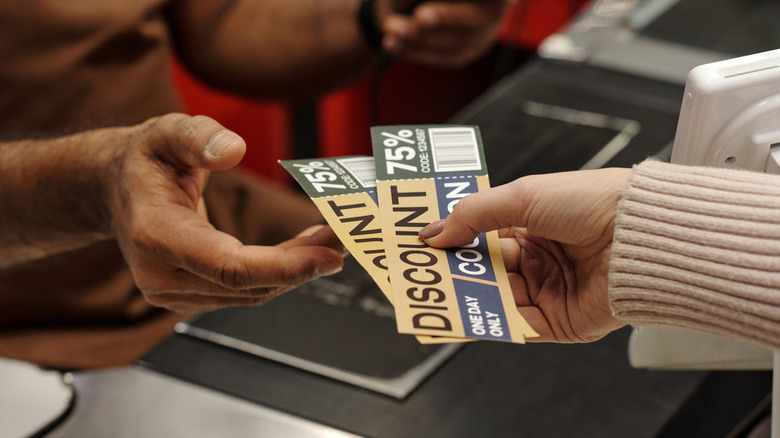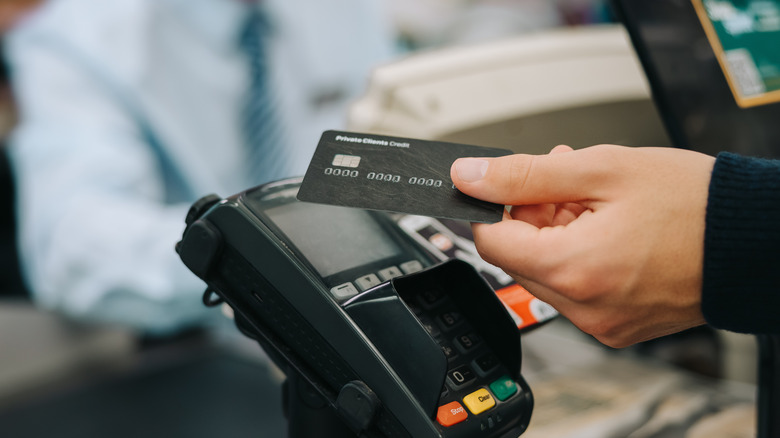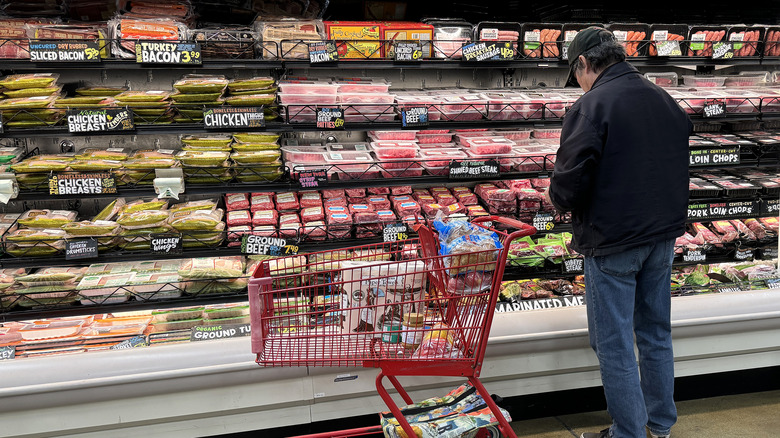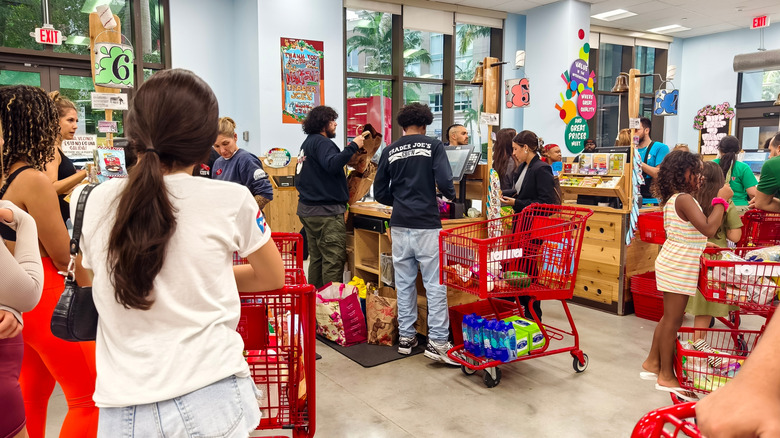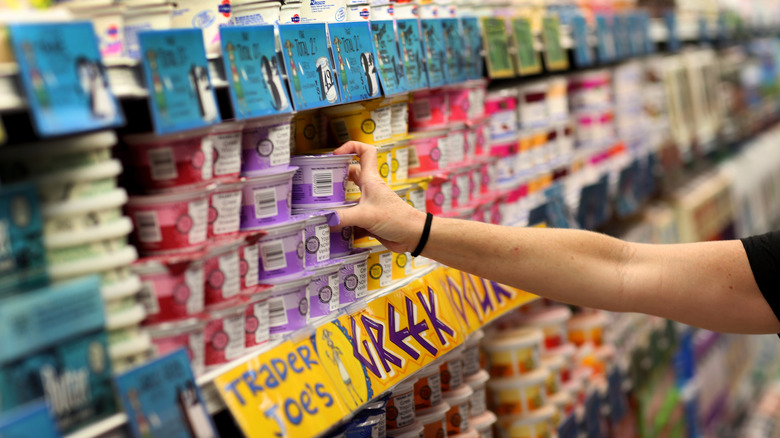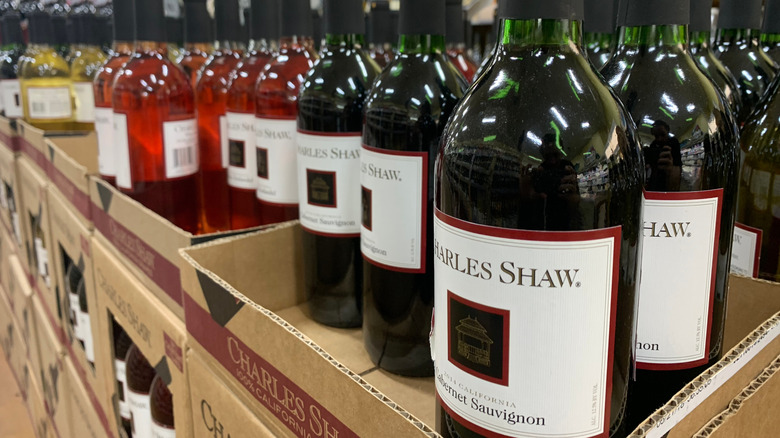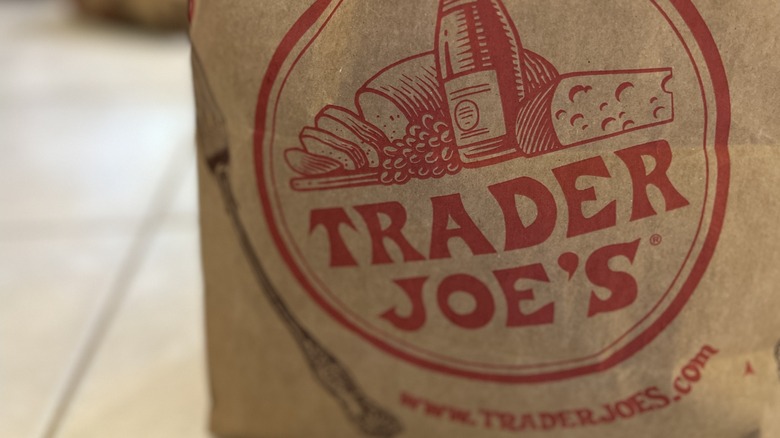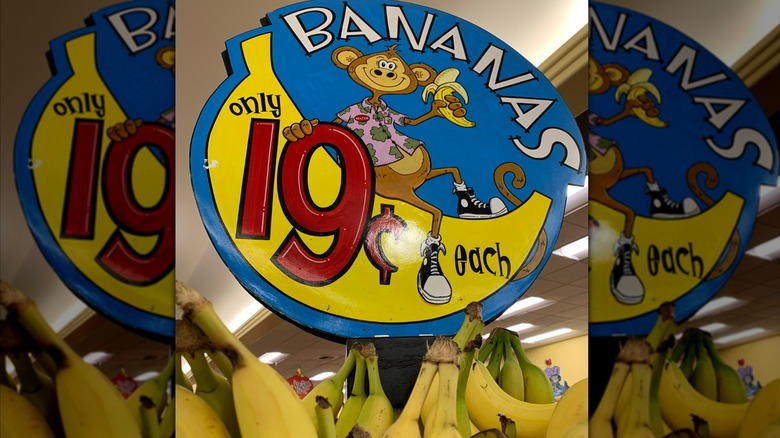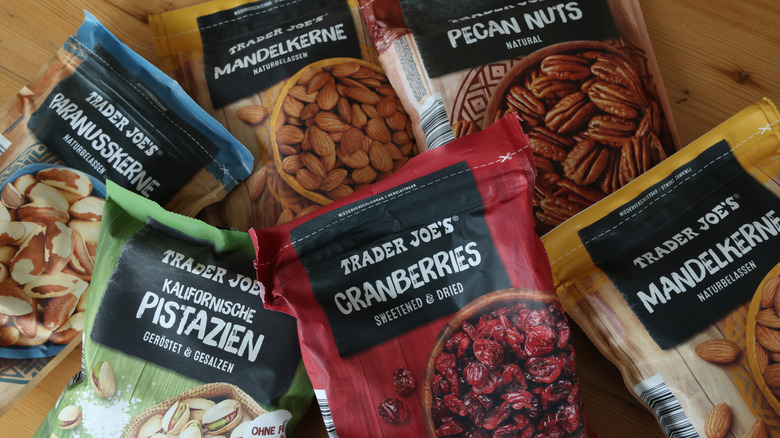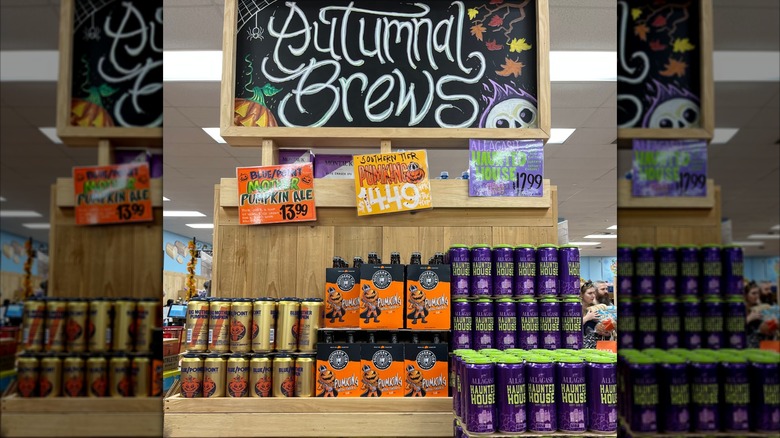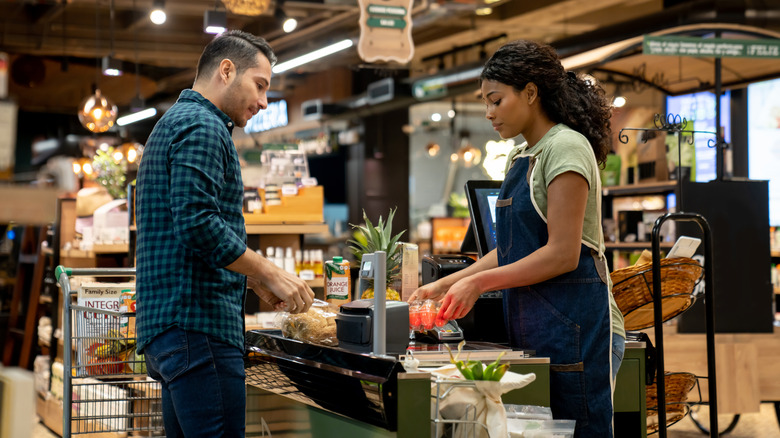False Things People Believe About Shopping At Trader Joe's
Part of the excitement of being a Trader Joe's shopper is that it feels like there's always something new to discover. This extends beyond the items on its shelves to the philosophy and policies embraced by the company, too. The truth about Trader Joe's is that, because there is so much to learn and know, even the most seasoned customer may be unaware of certain misconceptions that exist about shopping in their most preferred retailer.
What sort of false things are there to know about shopping at Trader Joe's, even if you're a regular among the aisles? Facts about the company's devotion to environmental responsibility, the possibility of sampling the goods before you buy them, and long-held beliefs about the price of certain products all turn out to be less than accurate when you scratch beneath the surface. The list goes on. Whether you're a novice patron or a long-time devotee, here's a list of inaccurate yet widespread beliefs about Trader Joe's that are bound to open the eyes and minds of anyone familiar with this chain's reputation as an innovative outlier in the grocery world.
The chain does coupons, sales, and online discounts
If you've ever headed into Trader Joe's with your coupons in hand, ready to haggle down the cost of a cart full of chocolates and soups, you may have been surprised to find out that manufacturer coupons are not honored at the store. Though coupons are a common and even encouraged phenomenon at grocery and big box outlets, believing you can use them at Trader Joe's has always been a falsehood, and as far as the company is concerned, it always will be.
In the same vein, you won't find a weekly sales advertisement showing rollbacks or markdowns. This is thanks to Trader Joe's ethos of keeping its prices low all the time rather than trying to entice patrons with hops and drops in its pricing structure. While it may not be as exciting as cracking open a print ad or website listing all the thrilling finds for the current week, it also means that you can count on prices being stable from visit to visit, which makes planning your Trader Joe's budget a whole lot more predictable. Trader Joe's would rather you know what you're getting ahead of time and be pleased with the value of each and every grocery shop.
There's a Trader Joe's loyalty club
You may be asked to produce your loyalty card when your purchases are run up at just about every other grocery store in your area, but sadly, the same is not true at Trader Joe's. The chain does not currently hold a loyalty program for its customers. The overarching concept of the chain is to provide high-quality products at affordable prices without requiring patrons to rack up bonus points or to open their purchase history through digital tracking by corporate muckety-mucks.
Theoretically, an exclusive card would help sell the specialness of a store that loves being unique. But when all grocery stores offer loyalty cards, maybe the true show of devotion is shopping with a company that doesn't make its customers jump through extra hoops just to get a good deal. If an easygoing one-stop shopping experience is the preference, Trader Joe's does its best to make everyone feel elite without requiring a special card or demanding your email address as proof.
You can find your favorite brands in Trader Joe's
Unsuspecting shoppers may stroll into Trader Joe's thinking that it's just a smaller version of their regular grocery store, stocking all the standard brands but with extra TJ-specific bells and whistles. However, the more seasoned patron can attest that this is not the case. You may find a few national brands on shelves and in cases, but by and large, Trader Joe's stocks selections from its own labels. Everything from chocolate bars to bagged salad to frozen dinners bears the Joe signature, all presented as high-quality stand-ins for more familiar versions.
Why would a boutique grocery chain not try to lure customers by offering products they already know and love? Well, the reason Trader Joe's doesn't sell name-brand items is that it gives the store more control over product prices and availability. Since the chain doesn't offer sales or coupons, it keeps prices largely affordable for exciting finds that customers have come to crave. It's a clever strategy that makes shopping at Trader Joe's feel like a special experience and adds to the fun inside the store.
You can order Trader Joe's groceries online for pickup or delivery
While it may be a norm in the 21st century for retailers to offer online ordering and at-home delivery, Trader Joe's has eschewed the to-your-door approach in favor of keeping the in-store experience at the heart of the business. The company believes that coming into a Trader Joe's is fundamental to receiving top-notch values without the additional fees or jacked-up prices found on third-party delivery sites. It gives the impression that despite its modern-retro sensibilities, the outlet is a little out of step with the times — and with what grocery shoppers prefer.
The company believes that although you may have to trek a bit to get your Trader Joe's frozen pasta or Everything But the Bagel seasoning, the island adventure atmosphere and helpful staff are sure to make the voyage worthwhile. For anyone who loves the Trader Joe's labels, it's not likely to cause a ruckus. But for potential shoppers who've gotten used to dialing up an order for curbside pickup or home delivery, it can be a deterrent they're not willing to overcome.
You can always find your favorite items
It only takes a few shopping runs to Trader Joe's for shoppers to discover that even the most essential items on the roster are often missing from shelves. With so much new taste and texture to experiment with, the company frequently releases items that aren't permanent fixtures. This doesn't keep customers from falling in love, however, but it does mean that the crush may be unrequited, and you may not be able to find a favorite in the future. Maybe it didn't catch on like the chain anticipated, or maybe it was simply time for a change. Either way, it's best to hold on loosely and resist becoming too attached to your go-to Trader Joe's snacks.
The hide-and-seek nature of Trader Joe's stock is most notable when seasonal items become available. Favorites like Candy Cane Joe-Joe's and Salted Caramel Hot Cocoa may show up in Trader Joe's flyers, but due to purposefully limited availability, many fans find a blank space when they finally make it in for a holiday shop. To avoid after-holiday overstock, the chain restricts production, an easy way to eliminate the need for clearance or possible waste of expired products. And because bulk purchases aren't forbidden, shoppers with a taste for holiday flavors may have filled their cart before you arrived. The lesson here: shop early and buy enough of what you want to last through the season.
Bulk orders are possible
Though you're welcome to stock up on the Trader Joe's items you hold dear, there's no way to arrange a pre-order of bulk quantities. This would make it challenging to provide enough stock for other customers, which is a key part of the company's philosophy. To prevent shortages due to massive backdoor orders, Trader Joe's makes no bones about keeping all sales within the confines of the stores themselves.
Another possible reason for resisting a corporate-minded move like bulk orders: Online resellers have less of a direct line to Trader Joe's stock, making it less likely that these smaller outlets will draw business away from the company. It's easy enough to find some Trader Joe's items being sold on Amazon. Imagine if these enterprising souls were able to order a gross of the chain's most treasured products. It could funnel away both revenue and customer satisfaction from stores that depend on both to stay afloat.
The chain's Two Buck Chuck wine actually costs $2
One of Trader Joe's best-known offerings is its inexpensive yet flavorful wine affectionately known as Two Buck Chuck. The Two Buck part of the name is self-explanatory. Traditionally, the wine has been priced at $2 per bottle, creating not just a fun moniker but also inspiring regular purchases by wine fans on a budget. And the Chuck part of the name? It comes from Charles Shaw, the winery that provides these tasty and economical bottles and stamps its brand on every label. So while you won't actually find the name "Chuck" on the bottle, the hand-lettered sign on the shelf will point you in the right direction.
But in a relatively recent plot twist that threw Trader Joe's wine fans into a tailspin, the name Two Buck Chuck lost its truth as prices increased. While prices vary depending on the location, you may be paying around $3.49 for your bottle of Chuck nowadays. Still, in today's market, paying less than $5 for a bottle of quality wine is still pretty impressive. And there's always a chance it'll roll back to $2 somewhere down the line.
Shopping at Trader Joe's is the eco-friendly choice
The small-town-grocer vibe and laid-back atmosphere definitely send earth-loving vibes throughout the Trader Joe's environment. While you'll find many fair-trade and earth-conscious items lining the racks, it doesn't take much to notice that there's a lot of plastic packaging keeping things fresh and firm. It turns out that feeling good about minimizing your carbon footprint by shopping at Trader Joe's may be limited to using the store's paper bags or bringing your own canvas totes — but choosing the mindful products is a solid move, too.
It's only been in the last decade that Trader Joe's has removed HCFCs, or hydrochlorofluorocarbons, from its air conditioning systems. These chemical propellants help keep things nice and cool, but they're also a major source of greenhouse gases that contribute to climate warming. Despite repeated requests made by the EPA throughout the early aughts, Trader Joe's made the move in June 2016 via a consent decree from the U.S. government. Not a good look for a modern company. Maybe Trader Joe's can work on reducing single-use plastic packaging next.
Bananas cost $0.19 each
For years, one of the best-known claims made by Trader Joe's stores was that you could always purchase a single banana for $0.19, no matter what prices and other grocery stores might offer. It was a standard in Trader Joe's lore and a fun fact to note on hand-lettered signs in the produce section. But even a boutique grocery store is subject to the pressures of increasing prices due to inflation and tariffs. Now, when you step up to the banana bin at your local Trader Joe's, don't be surprised to see that bananas have risen to a whopping $0.23 apiece. Count the $0.19 banana as one of those nice things we can't have.
Yes, yes, it's only $0.04 more per banana — a nominal amount for an item that can run a quarter or more in national chain stores. It's not unexpected for stores to raise prices to keep up with the cost of doing business, even stores with a non-traditional model like Trader Joe's. But for a store that created a folkloric reputation with its followers based partly on its cheap bananas, the old claim rings false now.
You can't sample before buying
How are you supposed to know if you want to purchase a particular product if you aren't able to try it first? If you're expecting workers at Trader Joe's to shut you down when you ask for a sample, your mind will be blown when you find out that you can take a taste of just about everything in the store, just by making a request. Of course, opening a package of quinoa and black bean tortilla chips to grab a handful on your own is definitely frowned upon. Ask for assistance, and the friendly workers will be glad to share the wares.
This feature can come in handy when shoppers encounter new releases that may or may not be what they're looking for. By letting customers try before they buy, Trader Joe's is betting on a full-fledged sale — and possibly repeat purchases from patrons who love what they've tried. So, the next time you're in Trader Joe's and you want to know what the latest twist on Joe-Joe's tastes like or you're curious about new fall specialties, just signal one of the helpful clerks and let them know what you're interested in taking for a taste test.
You have to buy full cases of drinks
Have you ever found yourself wanting to buy one or two items but, limited by availability, ended up purchasing a multipack instead? At Trader Joe's, you can crack open that multipack and purchase only as many as you want. It may be one of the lesser-known liberties allowed by the store, but it is a true phenomenon and one that expands the possibilities for sampling so many items around the store. It also invites beer fans to create their own custom collections from the various brews Trader Joe's rolls out throughout the year.
It's simple enough to grab a single of something you already love for a one- or two-drink occasion. If you're curious about pumpkin ale but not eager to buy a six-pack without knowing how it tastes, just snap off a single can and make a smaller purchase before committing to the whole box. Don't be afraid to break up the set; the company seems to be happy to sell a single serving, especially if it makes the customer happy and may lead to future sales.
All store label food items are non-GMO
Another falsehood perpetuated by Trader Joe's small-shop personality is that the items adhere to a mindful standard, particularly when it comes to GMOs. The company's official statement is that no GMOs are allowed into its private label items (the ones with the Trader Joe's name on the package). But dig a little deeper, and you'll find out that there's no independent verification that ensures Trader Joe's upholds its own standard. The reason seems to be that until the government requires labeling and better defines a GMO, the company isn't going to do too much labeling of its product.
To get more clarity on the situation, non-profit Non-GMO Project has reportedly made attempts to nail down Trader Joe's particulars on GMOs. Another watchdog group, The Cornucopia Institute, has also claimed that Trader Joe's has refused to take part in its research studies, making the company's line on the GMO issue even squishier. While many shoppers are fine with genetically modified organisms entering the food chain, the fact that Trader Joe's keeps its practice shrouded in mystery is a smudge on the company's perceived reputation of providing superior products.
You need a receipt to get a refund
The generosity of Trader Joe's is well-known by anyone who's ever needed to return an item that didn't measure up. But before you go scrounging around in the trash to find the receipt so you can get your cash back for that not-quite-fresh cup of yogurt, it's good to know that a receipt is not necessary to receive a refund. Yep, Trader Joe's is one of the stores with the liberal return policy that allows a no-receipt refund. The food you return doesn't have to be spoiled or stale to qualify. Even if you weren't pleased with how it tasted, you can still undo your error with no receipt required.
With such an open philosophy regarding customer satisfaction, it's important to remember not to abuse the Trader Joe's return policy. But keep an eye on the perishables you buy, items like meat, dairy, and produce, and if you find them to be moldy or mushy, you have a no-hassle way to get your money back. And on the off chance that you just don't like what you're tasting when you give something new a go, they'll give you your cash back for that, too.
